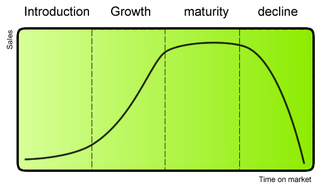
Sales are activities related to selling or the number of goods sold in a given targeted time period. The delivery of a service for a cost is also considered a sale. A period during which goods are sold for a reduced price may also be referred to as a "sale".
A software company is an organisation — owned either by the state or private — established for profit whose primary products are various forms of software, software technology, distribution, and software product development. They make up the software industry.
In business and engineering, product development or new product development covers the complete process of bringing a new product to market, renewing an existing product and introducing a product in a new market. A central aspect of NPD is product design, along with various business considerations. New product development is described broadly as the transformation of a market opportunity into a product available for sale. The products developed by an organisation provide the means for it to generate income. For many technology-intensive firms their approach is based on exploiting technological innovation in a rapidly changing market.
The rational unified process (RUP) is an iterative software development process framework created by the Rational Software Corporation, a division of IBM since 2003. RUP is not a single concrete prescriptive process, but rather an adaptable process framework, intended to be tailored by the development organizations and software project teams that will select the elements of the process that are appropriate for their needs. RUP is a specific implementation of the Unified Process.
Product management is the business process of planning, developing, launching, and managing a product or service. It includes the entire lifecycle of a product, from ideation to development to go to market. Product managers are responsible for ensuring that a product meets the needs of its target market and contributes to the business strategy, while managing a product or products at all stages of the product lifecycle. Software product management adapts the fundamentals of product management for digital products.

Product life-cycle management (PLM) is the succession of strategies by business management as a product goes through its life-cycle. The conditions in which a product is sold changes over time and must be managed as it moves through its succession of stages.
Marketing management is the organizational discipline which focuses on the practical application of marketing orientation, techniques and methods inside enterprises and organizations and on the management of a firm's marketing resources and activities.
The following outline is provided as an overview of and topical guide to software engineering:

In systems engineering and software engineering, requirements analysis focuses on the tasks that determine the needs or conditions to meet the new or altered product or project, taking account of the possibly conflicting requirements of the various stakeholders, analyzing, documenting, validating and managing software or system requirements.

In industry, product lifecycle management (PLM) is the process of managing the entire lifecycle of a product from its inception through the engineering, design and manufacture, as well as the service and disposal of manufactured products. PLM integrates people, data, processes, and business systems and provides a product information backbone for companies and their extended enterprises.
Requirements engineering (RE) is the process of defining, documenting, and maintaining requirements in the engineering design process. It is a common role in systems engineering and software engineering.
A software requirements specification (SRS) is a description of a software system to be developed. It is modeled after the business requirements specification (CONOPS). The software requirements specification lays out functional and non-functional requirements, and it may include a set of use cases that describe user interactions that the software must provide to the user for perfect interaction.

A product requirements document (PRD) is a document containing all the requirements for a certain product. It is written to allow people to understand what a product should do. A PRD should, however, generally avoid anticipating or defining how the product will do it in order to later allow interface designers and engineers to use their expertise to provide the optimal solution to the requirements.
Requirements management is the process of documenting, analyzing, tracing, prioritizing and agreeing on requirements and then controlling change and communicating to relevant stakeholders. It is a continuous process throughout a project. A requirement is a capability to which a project outcome should conform.
A product manager (PM) is a professional role that is responsible for the development of products for an organization, known as the practice of product management. Product managers own the product strategy behind a product, specify its functional requirements, and manage feature releases. Product managers coordinate work done by many other functions, and are ultimately responsible for product outcomes.
Rational Rhapsody, a modeling environment based on UML, is a visual development environment for systems engineers and software developers creating real-time or embedded systems and software. Rational Rhapsody uses graphical models to generate software applications in various languages including C, C++, Ada, Java and C#.
Presales is a process or a set of activities/sales normally carried out before a customer is acquired, though sometimes presales also extends into the period the product or service is delivered to the customer.
Digital Prototyping gives conceptual design, engineering, manufacturing, and sales and marketing departments the ability to virtually explore a complete product before it's built. Industrial designers, manufacturers, and engineers use Digital Prototyping to design, iterate, optimize, validate, and visualize their products digitally throughout the product development process. Innovative digital prototypes can be created via CAutoD through intelligent and near-optimal iterations, meeting multiple design objectives, identifying multiple figures of merit, and reducing development gearing and time-to-market. Marketers also use Digital Prototyping to create photorealistic renderings and animations of products prior to manufacturing. Companies often adopt Digital Prototyping with the goal of improving communication between product development stakeholders, getting products to market faster, and facilitating product innovation.
In software engineering, a software development process is a process of planning and managing software development. It typically involves dividing software development work into smaller, parallel, or sequential steps or sub-processes to improve design and/or product management. It is also known as a software development life cycle (SDLC). The methodology may include the pre-definition of specific deliverables and artifacts that are created and completed by a project team to develop or maintain an application.
Product marketing is a sub-field of marketing that is responsible for crafting the messaging, go-to-market flow, and promotion of a product. Product marketing managers can also be involved in defining and sizing target markets. They collaborate with other stakeholders including business development, sales, and technical functions such as product management and engineering. Other critical responsibilities include positioning and sales enablement.





